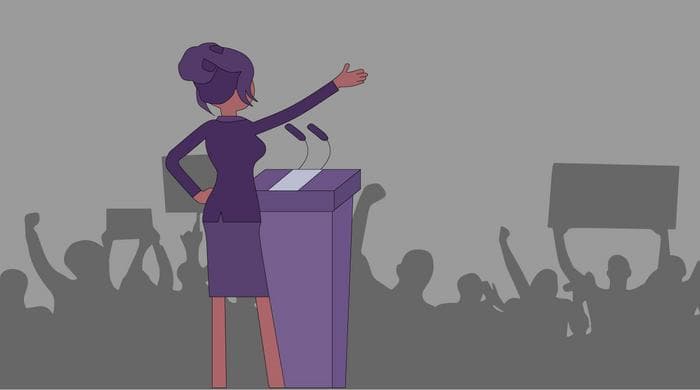Vertical wide gestures enhance perception of body height

Want to appear taller when speaking in public?
According to research, you should use vertical gestures. Up/down hand movements are associated with energy and an eagerness to dominate.1 Wider movements strengthen this association. Viewers tend to perceive dominant individuals as larger.
Horizontal gestures do not show this effect.
… horizontal movements are difficult to be performed with great vigor and therefore they might be related to calmness and emotional stability2
Practice performing 5 basic gestures: push, pull, lift, throw, and tear, in an upward/downward, inward/outward motion. Practice in front of a mirror or using video recording.
Gesture more
Socially influential people often accompany their speech with energetic gestures.3
Vary intensity
It’s better to alternate the speed of gesturing: fast/slow. Constant active movements can eventually appear aggressive and be poorly perceived.
Expand amplitude
Wider movements are better than shorter ones. First ones are perceived as confident, while second ones are seen as nervous. However, frequent wide vertical movements can reduce speaker’s attractiveness as they may convey aggression. It’s better to occasionally switch to horizontal movements.4
Gesture above chest
Movements at neck and head level will draw attention to upper part of body. This will raise the level of observer’s eyes, which in turn can create an illusion of height.
Use appropriate gestures
Subordination should be observed. You can move widely and actively during dancing or in other informal situations but it may be misinterpreted during presentation to investors, for example.
-
Koppensteiner, M., Stephan, P., & Jäschke, J. (2018). Want to gain height? How body motion makes you taller. https://doi.org/10.31234/osf.io/364sb ↩
-
Koppensteiner, Markus (2013). Motion cues that make an impression. Journal of Experimental Social Psychology, 49(6), 1137–1143. doi:10.1016/j.jesp.2013.08.002 ↩
-
Dana R. Carney; Judith A. Hall; Lavonia Smith LeBeau (2005). Beliefs about the nonverbal expression of social power. , 29(2), 105–123. doi:10.1007/s10919-005-2743-z ↩
-
Markus Koppensteiner; Karl Grammer (2010). Motion patterns in political speech and their influence on personality ratings. , 44(3), 374–379. doi:10.1016/j.jrp.2010.04.002 ↩
Posted on
